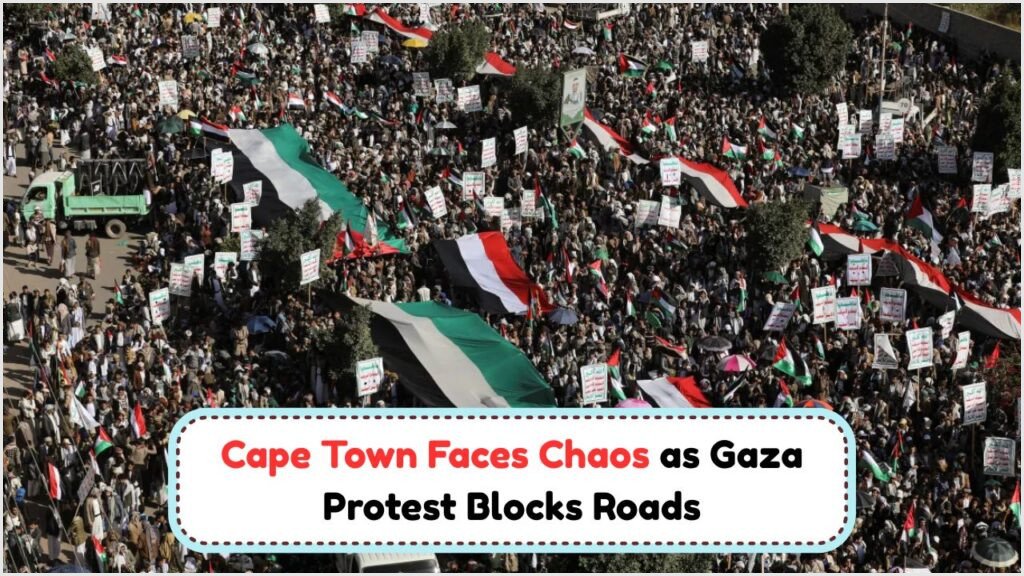Cape Town’s August 16 Protest: Pots and Pans Echo Globally as Gaza War Movement Gains Traction: On August 16, Cape Town resonated with the clatter of pots and pans as thousands rallied in a spirited protest against the ongoing conflict in Gaza. This unique demonstration was part of a larger global movement that has been gaining momentum, seeking to draw attention to the humanitarian crisis and calling for peace. The protest, which saw participation from diverse communities across the city, highlighted South Africa’s historical role in advocating for human rights and its solidarity with international causes.
The Rise of the Pots and Pans Protest in Cape Town
The origins of the pots and pans protest can be traced back to Latin America, where citizens used this method to voice their dissent against political issues. In Cape Town, this form of protest has taken on a new life, symbolizing the clamor for justice and peace in Gaza. On the day of the protest, the streets were filled with people from all walks of life, united in their call for an end to the violence. The use of everyday kitchenware as a tool for protest not only made a powerful auditory statement but also underscored the grassroots nature of the movement, making it accessible to all.
- The protest was organized by local activist groups.
- It drew attention from international media.
- Participants included families, students, and religious leaders.
- The protest was peaceful and well-organized.
- It aimed to pressure global leaders into action.
- Social media played a significant role in mobilization.
- The protest coincided with similar events worldwide.
- Local authorities facilitated the demonstration.
Global Impacts of the Cape Town Protest
The Cape Town protest was not an isolated event but part of a coordinated global response to the crisis in Gaza. The city’s unique approach of using pots and pans resonated internationally, highlighting the power of collective action in advocating for change. This form of protest, known as ‘cacerolazo,’ has become a symbol of peaceful resistance and has been adopted by various movements around the world. The global echo of the Cape Town protest was felt in cities across Europe, the Americas, and the Middle East, showcasing the interconnectedness of today’s activist movements.
 Discover the Fastest Way to Unlock NSFAS Funds: Thousands Swear by This Proven Appeal Format!
Discover the Fastest Way to Unlock NSFAS Funds: Thousands Swear by This Proven Appeal Format!
| City | Date | Event | Participants | Outcome |
|---|---|---|---|---|
| Cape Town | August 16 | Pots and Pans Protest | Thousands | Global Awareness |
| London | August 17 | Solidarity March | Hundreds | Media Coverage |
| New York | August 18 | Vigil | Thousands | Community Mobilization |
| Paris | August 19 | Peace Rally | Hundreds | Political Engagement |
| Berlin | August 20 | Protest | Thousands | Policy Discussion |
| Madrid | August 21 | Demonstration | Hundreds | Government Response |
| Toronto | August 22 | Awareness Event | Thousands | Increased Donations |
| Rome | August 23 | Peace March | Hundreds | Public Discourse |
Voices from the Cape Town Protest Movement
One of the most compelling aspects of the Cape Town protest was the diversity of voices that came together to advocate for peace. Participants ranged from seasoned activists to first-time protestors, all united by a shared desire to see an end to the violence in Gaza. Many carried signs and banners, while others simply banged their pots and pans to make their voices heard. The protest provided a platform for individuals to share their personal stories and express their solidarity with those affected by the conflict.
Key Messages from the Protest
- End the violence in Gaza.
- Promote peace and dialogue.
- Support humanitarian efforts.
- Hold global leaders accountable.
- Raise awareness of the conflict.
- Encourage international cooperation.
- Foster understanding and empathy.
- Highlight the power of peaceful protest.
Community Impact and Response
The Cape Town protest had a significant impact on the local community, fostering a sense of unity and purpose among participants. It served as a reminder of the power of collective action and the importance of standing in solidarity with those in need. The protest also sparked important conversations about South Africa’s role in international affairs and the country’s long-standing tradition of advocating for human rights. In the days following the protest, there was a noticeable increase in community engagement, with many individuals and organizations continuing to advocate for peace and justice.
Lasting Effects of the Protest
- Increased awareness of the Gaza conflict.
- Strengthened community bonds.
- Greater engagement in global issues.
- Enhanced solidarity with international movements.
- Ongoing advocacy efforts.
- Inspiration for future protests.
- Support for humanitarian causes.
- Encouragement of peaceful dialogue.
The Role of Social Media in the Protest Movement
Social media played a crucial role in the success of the Cape Town protest, serving as a powerful tool for mobilization and communication. Platforms like Twitter, Facebook, and Instagram were used to spread the word about the protest, share updates, and amplify the voices of participants. The use of hashtags and viral videos helped to draw attention to the cause and engage a global audience. This digital activism complemented the on-the-ground efforts, creating a multifaceted approach to advocacy that proved effective in raising awareness and garnering support.
Social Media Highlights
 August 17, 2025: R1,250 Foster Child Grant Payout Begins – Ensure You Receive Your SMS Alert!
August 17, 2025: R1,250 Foster Child Grant Payout Begins – Ensure You Receive Your SMS Alert!
- #CapeTownProtest trended globally.
- Viral videos reached millions.
- Photos captured the spirit of the event.
- Live streams provided real-time updates.
- Influencers amplified the message.
- Online discussions fostered engagement.
- Global solidarity was evident online.
- Digital campaigns complemented street protests.
FAQs About the Cape Town Protest
What was the main goal of the Cape Town protest?
The main goal was to raise awareness about the conflict in Gaza and advocate for peace and justice.
How did the protest impact the local community?
It fostered a sense of unity and purpose, encouraging greater engagement in global issues.
What role did social media play in the protest?
Social media was crucial for mobilization, spreading awareness, and engaging a global audience.
Were there similar protests in other parts of the world?
Yes, the Cape Town protest was part of a global movement with similar events in cities worldwide.
What is the significance of using pots and pans in the protest?
Pots and pans symbolize grassroots activism and create a powerful auditory statement for peace.
How did the August 16 protest in Cape Town resonate globally?
Pots and pans echoed worldwide, supporting Gaza war movement.




